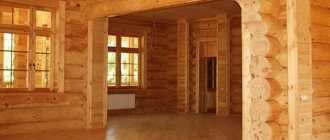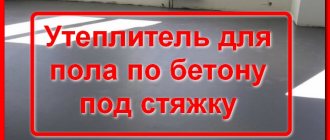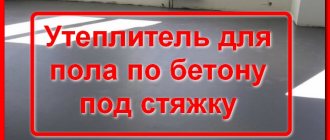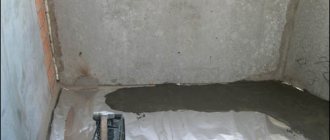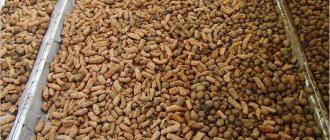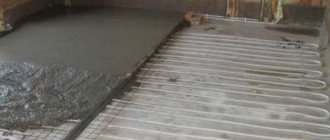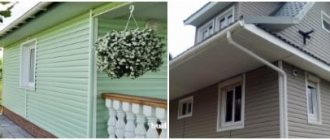How well the heat will be retained in the house largely depends on how well its foundation is made and insulated. A well-equipped foundation and the right material for floor insulation will reduce heat loss and help maintain a comfortable temperature in the room.
Floor screed with foam plastic
The issue of floor insulation is especially acute for residents of apartments on the lower floors, as well as private houses. Based on practical experience, we can say that in the case of creating a concrete screed, the most optimal solution would be to use polystyrene foam as a thermal insulation material. After all, it not only prevents heat loss, but also has a number of other advantages.
Styrofoam
Advantages of using polystyrene foam
Many experts consider foam plastic an ideal material for floor insulation. It is quite affordable and boasts many useful properties:
- high level of thermal insulation - polystyrene foam retains heat well, which is due to its structure consisting of round granules. There is an air cushion between them that prevents the leakage of warm air;
- excellent level of sound insulation - the foam layer in the floor screed will protect the neighbors below from various noises, primarily from the sounds of footsteps;
- fire resistance - this material is characterized by a short burning period and has the ability to self-extinguish. Even if during a strong fire the fire reaches the foam layer, no harmful compounds will be released when heated;
- long service life - foam plastic is not subject to shrinkage, rotting and can last for several decades without losing its characteristics.
Polystyrene foam is perfect for floor insulation
All these properties make this material an excellent solution for floor insulation. In addition to all of the above, it is easy to machine and is extremely simple to use.
Characteristics of foam plastic
| Brand of foam boards | PSB-S15 | PSB-S25 | PSB-S25F | PSB-S35 | PSB-S50 |
| Material density, kg/m3 | 10-11 | 15-16 | 16-17 | 25-27 | 35-37 |
| Compressive strength at 10% linear deformation, MPa, not less | 0,05 | 0,1 | 0,12 | 0,16 | 0,16 |
| Bending strength, MPa, not less | 0,07 | 0,18 | 0,2 | 0,25 | 0,3 |
| Thermal conductivity in dry condition at a temperature of 25 (+-5 degrees), W / (m * K), no more | 0,037 | 0,035 | 0,037 | 0,033 | 0,041 |
| Humidity of slabs, %, no more | 1 | 1 | 1 | 1 | 1 |
| Self-combustion time, sec, no more | 3 | 3 | 3 | 3 | 3 |
| Water absorption in 24 hours, %, no more | 1 | 1 | 1 | 1 | 1 |
| Service life, years (minimum-maximum) | 20-50 | 20-50 | 20-50 | 20-50 | 20-50 |
Advantages of expanded polystyrene concrete
In the production of polystyrene concrete, various additional components can be used, but it is the combination of concrete and polystyrene granules that gives the material valuable qualities for construction - strength, resistance to rotting, fire safety. Advantages of expanded polystyrene concrete:
- good heat and sound insulation properties;
- belongs to the group of low-flammable materials G1;
- plasticity sufficient for the manufacture of window and door lintels;
- high structural strength;
- light weight and ease of handling;
- frost resistance;
- wide scope of application.
An important advantage is the ability to independently prepare polystyrene concrete, for example, for insulating floors and roofs.
Necessary materials to create a screed
In the case when foam plastic or other heat insulators are used to insulate a concrete screed, it is called floating, since there is a layer between the base and the floor covering itself that does not allow the construction of a rigid structure.
To briefly describe the process of creating such a screed, a waterproofing material is laid on a leveled base to prevent moisture concentration. Then there is a foam layer, which is covered with a reinforcing frame and filled with cement-based mortar.
Before you begin, you should find out what tools and materials you will need.
Necessary tools for floor screed
Tools you should get:
- containers in which you can prepare a cement composition;
- a drill and a special mixing attachment;
- building level;
- trowel;
- spatula;
- rule.
You won't need a lot of materials:
- cement;
- sand;
- water;
- waterproofing agent;
- foam boards;
- mesh for reinforcement.
Polystyrene foam is available on the market in a wide range, but in any case remains an affordable material. When choosing slabs for screed, preference should be given to specimens no thicker than 5 cm. This thickness is quite enough for the resulting structure to cope with a load of up to 14 tons. For residential buildings, such characteristics are optimal, even taking into account that during operation, deformation of the foam up to 10% is possible.
foam sheet
Ruberoid
The role of waterproofing is usually performed by roofing felt, bitumen mastic or high-density polyethylene film. The choice of material depends on the needs of the home owner and his financial capabilities.
Preparation of the solution
You can use a concrete mixer
You can also use a construction mixer or a drill with an attachment
Particular attention should be paid to preparing the cement mortar for the screed. First, mix cement and sand in a ratio of 1:3, and then gradually begin to introduce water until the solution reaches the desired consistency. To avoid the appearance of lumps and speed up the process of preparing the mixture, use a drill with an attachment.
waterproofing
Cement mortar
Use with underfloor heating system
When installing a heated floor system with your own hands on the ground floor, it is also rational to use polystyrene foam or expanded polystyrene. The floor pipes are laid in the thickness of the cement layer, which in this case is made thicker than 80 mm. To increase strength, reinforcing mesh is used. A layer of polystyrene foam under the insulation ensures maximum system efficiency.
Options for underfloor heating
This video discusses all the technical details of installing a semi-dry screed on polystyrene foam:
Preparatory work before pouring the screed
If the base is concrete, then it is enough to clean it, and it will be ready for further actions. All existing cracks and irregularities are eliminated using tile adhesive.
Repairing cracks and leveling the floor with tile adhesive
When a concrete slab cannot boast of a perfectly even laying, differences can be leveled out using a layer of sand or foam granules.
Foam granules
Before laying waterproofing, the evenness of the base must be checked with a building level.
Checking the levelness of the floor
Creating a screed on a ground surface is a slightly more difficult task in terms of preparation. First of all, the base must be leveled and compacted properly. A gravel or crushed stone layer about 10 cm thick is laid on top of the soil and compacted well. Then comes exactly the same layer of sand.
To get a level floor, you need to make markings on the walls. First, notches are made in the corners of the room using a water level, and then, using a cord, the markings are turned into a solid line. The resulting mark will serve as a guide, helping to maintain the desired level of the future surface.
Marking walls using a water level and painting thread
When the base and markings are prepared, it is time to lay the waterproofing layer. The material that protects against moisture accumulation should be placed on the walls and end slightly above the level of the finished screed. If piece material is used for the waterproofing layer, then its individual elements are overlapped and secured together with tape.
Waterproofing
The isolated base is filled with cement mortar on top. As a result, the layer thickness should be about 40 mm.
Foam layer and screed filling
The polystyrene foam is placed on the still wet rough screed; laying begins from the wall opposite the doorway. Arrange the insulation elements in a checkerboard pattern, securing them manually using rubbing movements. The seams are covered with construction tape, which prevents the penetration of the cement composition into the layer. Then work stops for several days until the heat-insulating layer dries completely.
Laying foam boards
Installation of foam plastic for flooring under screed
When the foam is securely fixed to the base, proceed to laying the reinforcing layer. As a rule, to create it, a metal mesh with cell dimensions of 10*10 cm is used. But it cannot be laid directly on polystyrene foam - this will lead to the loss of its functional purpose, which is to reduce the pressure on the insulation. Plastic supports are installed on the foam layer to hold the mesh suspended.
Reinforcing mesh laid
To ensure uniform distribution of the solution over the entire surface, beacons must be installed. They can be placed in any order, and the step between elements should not be greater than the length of the rule.
The cement mortar is prepared immediately before use; it covers the foam and mesh. When the reinforcing layer completely disappears under the cement mixture, it must be thoroughly compacted. Completion of work with the screed can be carried out in two ways:
- the floor is leveled along the beacons;
- lighthouses are equipped with profiles for gypsum boards, and alignment is already carried out using them.
In any case, the final cement layer should be approximately 8 cm thick. After 3 days, you can safely walk on the screed, and resumption of repair work is possible within a week after it is poured. However, the surface will acquire the necessary strength only after 28 days, when it is completely dry. At this time, the screed is periodically sprayed with water, preventing it from drying out, which will lead to the appearance of cracks.
floor screed
Concreting
In general, complaints about cracking of cement screed can be heard quite often. Such a nuisance appears as a consequence of a violation of process technology. Especially in case of refusal to cut shrinkage seams when working in large rooms. Seams are created 12 hours after the completion of pouring the cement layer.
The depth of the seams should be approximately one third of the thickness of the screed. A special tool is used to cut them.
After the surface has completely hardened, they begin laying the floor covering, which can be absolutely anything. When thermal insulation is carried out correctly, and there are no cracks in the walls and ceiling that release heat, the floor temperature will remain at room temperature.
| Flooring | Prices, rub/m2 |
| Linoleum | 100-700 |
| Polyvinyl chloride coatings | On average from 1000 |
| Cork covering | On average from 1600 |
| Laminate | 170-1250 |
| Tile | 300-1500 |
| Carpets | 70-2000 |
| Parquet | 1000-2600 |
| Self-leveling floors | On average from 800-1000 |
Video description
This video shows the process of preparing a solution for polystyrene concrete screed:
Ivsil Termolite
This composition differs from those listed above in the type of filler. Here the manufacturer uses granulated foam glass. In this way, a cement leveler density of almost 500 kg/cubic meter is achieved. Therefore, the material is positioned as a type of ultra-light floor screed.
The compressive strength of the sample reaches 7 MPa. In this case, the minimum permissible layer is only 7 mm. But when using elastic finishing materials, the limit must be increased by at least 3 mm.
The scope of application of the material extends to both mineral and wooden subfloors. Regarding operating conditions, premises with any level of humidity are considered. It is allowed to carry out work on covered balconies and loggias, verandas and terraces.
Granulated foam glass Source granulin.ru
Paladium Palafloor-307
A mixture of modified cement and granulated foam glass with a fraction of up to 4 mm is distinguished by the minimum density of the screed compared to the samples under consideration. The thickness of the leveling coating can range from 20 to 300 mm. With a minimum layer, the dry mixture consumption is 8-9 kg. The compressive strength of the screed is 7 MPa. The working time of the solution is 4 hours. To prepare the mass, 5.4-6 liters of water are required (12 kg bag).
DIY options
One of the reasons for abandoning factory mixtures in favor of “homemade” ones is the high cost of the former. It is also often necessary to choose the second option due to the lack of the necessary mixtures on trading floors in a particular area and expensive delivery. Let's consider what solutions may be relevant and practical when installing lightweight floor screeds in the house.
Expanded clay
The material is used in fractions up to 5 mm. You can use a dry screed mixture as an alternative. Fired clay has a porous structure, therefore it has good sound insulation and thermal conductivity properties.
Ready-made expanded clay backfill for dry screeding Source pinimg.com
The material is characterized by resistance to changes in humidity, but the granules are destroyed by prolonged contact with water. Resistance to many chemicals and mold and fungi is also observed. As the solution dries, it shrinks slightly when forming any layer.
Introducing foam granules into the solution
Introducing foam granules into the solution
To create a concrete screed with foam plastic, slab material is not always used, because the surface can be given additional performance properties by introducing granules into the cement mortar. Foam granules will create an air layer, thereby ensuring good thermal insulation performance of the screed. This process is carried out in several stages.
Foam chips with cement
- A solution is prepared consisting of a small amount of water and the volume of cement required to obtain a mixture of creamy consistency. The mixing process becomes much faster and more efficient when using a drill with a suitable attachment.
- Continuing mixing, foam granules are added to the mixture. The ratio of ingredients varies: one part of concrete can contain three, four or even six parts of granular material.
The higher the percentage of granules in the solution, the better the thermal insulation properties of the screed. However, at the same time, it will be less durable, and when pressed it may even crumble, therefore, it will lose the lion’s share of its performance characteristics.
Foam chips are a material that solves the most pressing problems, being an ideal insulation material that is resistant to fires, severe fires and other types of damage, and at the same time economical and high quality
The choice of the desired proportion largely depends on how durable and rigid the finishing floor covering will be. For example, if you plan to use linoleum, then the volume of granules in the solution should be minimal, parquet - vice versa.
foam granules
Video - Polystyrene foam granules. Mixing with cement
Some advice from professionals
Despite the fact that creating a screed with foam plastic is not a very complicated process and even an amateur who carries out all the technological steps can cope with it, there are several nuances that need to be remembered:
- The optimal thickness of the foam used in screeding is considered to be 5 cm, but this rule applies to apartments located above the second floor. If the apartment is on the ground floor or we are talking about renovating a private house, then the material should be taken with a greater thickness, for example 10 cm;
- As a rule, the foam layer is located between the waterproofing material and the floor screed, that is, as if “under the cement.” However, sometimes it is laid on a screed under the finishing floor covering; this approach is possible when using wood as the last layer;
- When choosing a reinforcing mesh, you definitely shouldn’t save money, because it will serve as a frame that takes the main load on the floor and protects the heat-insulating layer from deformation.
Screed diagram with foam plastic
Taking into account the opinion of experts and following the stages of technology for arranging an insulated screed, you can make your home much more comfortable to live in. It is not for nothing that polystyrene foam is considered the optimal material for thermal insulation, because a 12 cm thick slab retains heat no worse than brickwork 2 meters thick. Foam boards are not afraid of high humidity, since they practically do not absorb water.
Speaking about the environmental friendliness and safety of polystyrene foam, it is worth noting that it is in boxes made of this material that donor organs are transported and food is packaged. In addition, it does not cause allergic reactions. There is no more effective material for insulating concrete floors yet, which explains the popularity of this design, which can last for many years, maintaining all its performance characteristics and providing a comfortable room temperature.
Solving the price-quality issue
, polystyrene foam and extruded polystyrene foam can be used together to maintain the quality of insulation and reduce the price.
The use of these two materials in combination is an excellent solution to the price-quality issue.
In this case, the concrete floor pie will be:
- Reinforced concrete slabs or monolith;
- foam layer, approximately 50-100 mm;
- layer of extruded polystyrene foam, approximately 30-50 mm;
- layer of cement-sand mortar;
- flooring.
The thermal performance indicators of these materials are similar, so the thickness will increase slightly due to the addition of polystyrene foam. The top durable layer can withstand high loads and save on screed reinforcement.
Also read about floor insulation with polystyrene foam in a wooden house.
